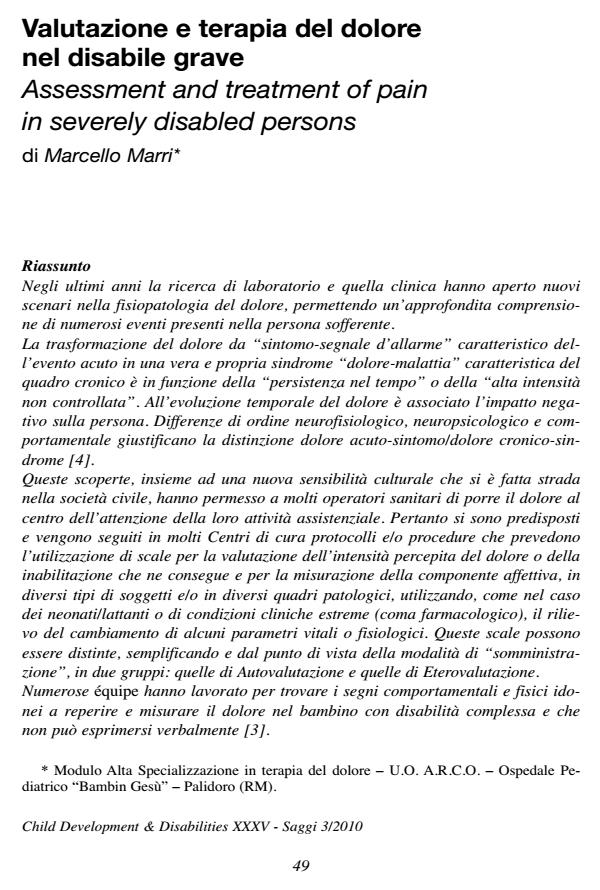Assessment and treatment of pain in severely disabled persons
Journal title CHILD DEVELOPMENT & DISABILITIES - SAGGI
Author/s Marcello Marri
Publishing Year 2012 Issue 2010/3
Language Italian Pages 6 P. 49-54 File size 54 KB
DOI 10.3280/CDD2010-003008
DOI is like a bar code for intellectual property: to have more infomation
click here
Below, you can see the article first page
If you want to buy this article in PDF format, you can do it, following the instructions to buy download credits

FrancoAngeli is member of Publishers International Linking Association, Inc (PILA), a not-for-profit association which run the CrossRef service enabling links to and from online scholarly content.
In recent years laboratory and clinical research have opened new scenarios in the physiopathology of pain, allowing an in-depth understanding of several events concerning the patient. The transformation of pain from "symptom as an alarm sign" - characteristic of the acute events - into a real syndrome "pain-disease" - characteristic of a chronic condition - is linked to its persistence over time or to its uncontrolled high intensity. Temporal evolution of pain is associated to the negative impact on the person. Neurophysiological, neuropsychological and behavioral differences explain the distinction between acute pain symptom and chronic pain syndrome (4). These findings, together with a new cultural awareness that has made its way into civil society, have allowed many health professionals to focus on pain as a central part of their care activities. In many centers protocols and/or procedures are therefore prepared and followed, which provide the use of scales for assessing the perceived intensity of pain or the subsequent lack of ability and for measuring the emotional component in different types of subjects and/or in different pathological conditions. It is the case of babies/infants or of extreme clinical conditions (drug coma) where changes of some essential or physiological parameters are employed. These scales can be distinguished by simplifying in two groups: those of self-assessment and those of hetero assessment. Several teams have worked to find out the appropriate physical and behavioral signs to detect and assess pain in children with complex disability that are not able to express themselves verbally (3). In France, the team of the Hospital San Salvadour (Hyères) developed a scale of 10 items, the DESS (Douleur Enfant San Salvadour) modeled on the DEGR (Douleur Enfant Gustave Roussy). The 10 steps are related to changes of neurological usual signs when there is pain.(2) A Canadian group has developed and validated a list of 30 items that is quite simple (screaming, crying, whining, grimacing etc.) This list, known as the NCCPC (Non-Communicating Children’s Pain Checklist), does not require a previous relationship with the child with disabilities (1). We can use two different approaches to treat pain: trying to interfere with the excitatory system by filtering or inhibiting the transmission of the painful messages; strengthening the inhibitory system. Means to reduce pain are numerous and complementary and good results are often obtained by using them together.
Keywords: Disabilities, physiopatology of pain, assessment scale of pain, strategy in pain treatment
Marcello Marri, Valutazione e terapia del dolore nel disabile grave in "CHILD DEVELOPMENT & DISABILITIES - SAGGI" 3/2010, pp 49-54, DOI: 10.3280/CDD2010-003008